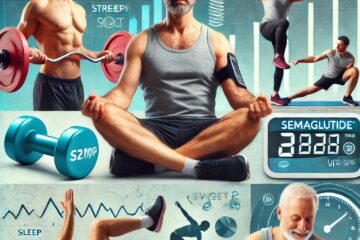Compound vs. Isolation Exercises for Men Over 40: What’s Best for You?

As men age, maintaining strength, flexibility, and overall health becomes increasingly important. For men over 40, choosing the right exercise regimen can help improve not just physical fitness but also quality of life. Two primary categories of strength training exercises—compound and isolation—offer different benefits. Understanding the distinction between the two can help men over 40 build strength efficiently while reducing the risk of injury.
What Are Compound Exercises?
Compound exercises involve multiple muscle groups and joints at the same time. Examples include squats, deadlifts, bench presses, pull-ups, and rows. These exercises mimic real-life movements and are highly effective for building functional strength, coordination, and balance.
Benefits of Compound Exercises for Men Over 40:
- Increased Efficiency: Since multiple muscles are worked simultaneously, compound exercises save time and allow for more comprehensive workouts.
- Boosts Metabolism: Engaging larger muscle groups in compound movements burns more calories and can help men manage body fat, which becomes harder to control with age.
- Improves Functional Strength: Compound exercises often mimic daily movements, making it easier to perform everyday tasks such as lifting objects, getting up from a chair, or even playing with grandchildren.
- Better Hormonal Response: Compound exercises can stimulate greater testosterone production, which is important for muscle maintenance, bone density, and overall energy levels in men over 40.
- Joint Health and Mobility: Movements like squats and deadlifts help keep joints mobile and improve flexibility, both crucial for aging men.
What Are Isolation Exercises?
Isolation exercises target a single muscle group or joint, such as bicep curls, leg extensions, and tricep pushdowns. These exercises are great for specifically developing or rehabilitating muscles but don’t involve as many muscles or burn as many calories as compound exercises.
Benefits of Isolation Exercises for Men Over 40:
- Focused Muscle Development: Isolation exercises allow for targeted muscle growth and can help address muscle imbalances or weak points, such as a lagging chest or biceps.
- Lower Risk of Injury During Execution: Since fewer muscles and joints are involved, isolation exercises can be easier to perform with proper form, reducing the risk of injury when done correctly.
- Rehabilitation and Prehab: Isolation exercises can be excellent for rehabilitation after injury or for working on specific areas that need attention to prevent future injuries.
- Supplemental to Compound Movements: When combined with compound exercises, isolation exercises can enhance muscle definition and ensure that smaller muscle groups get adequate attention.
Which Type of Exercise is Best for Men Over 40?
For men over 40, it’s important to incorporate both compound and isolation exercises into a fitness routine, but the focus should typically be on compound movements. Here’s why:
- Time Efficiency: As men age, they often have less time for long workout sessions. Compound exercises work multiple muscle groups at once, making them more efficient for men who want to maximize their workouts.
- Maintaining Functional Strength: As we age, maintaining the ability to perform day-to-day activities with ease becomes critical. Compound exercises offer greater functional strength benefits than isolation exercises, as they mirror the natural movements your body performs in daily life.
- Injury Prevention: Strengthening muscles around the joints and improving mobility is crucial for reducing the risk of injury. Compound exercises help strengthen the core, hips, and back—areas that are vital for maintaining good posture and preventing lower back or knee problems, which are common as men age.
- Longevity: Training with compound movements helps preserve muscle mass, bone density, and cardiovascular health—all essential for healthy aging.
How to Incorporate Both into Your Routine
- Focus on Compound Movements: For overall strength and health, build your workouts around big compound lifts like squats, deadlifts, presses, and rows. Start your workout with these exercises when your energy is highest.
- Add Isolation Exercises for Weak Points: After completing your compound exercises, incorporate isolation exercises to target specific muscles or work on areas where you feel underdeveloped, such as the arms, shoulders, or calves.
- Modify Based on Goals: If your goal is overall strength and fitness, prioritize compound movements. However, if you’re aiming to sculpt particular muscles or need to rehabilitate an injury, give more attention to isolation exercises.
Safety Considerations for Men Over 40
- Warm-Up: A proper warm-up becomes more important as you age. Dynamic stretches and light cardio can increase blood flow and reduce the risk of injury during your workout.
- Prioritize Recovery: Recovery is key to preventing injuries. Allow enough rest between workouts and consider incorporating yoga or mobility exercises to aid in recovery and keep joints supple.
- Form Over Weight: As men age, lifting heavy with improper form can lead to injuries. Prioritize good form in both compound and isolation exercises, and choose weights that allow you to move through the exercise with control.
- Consult a Professional: If you’re new to exercise or haven’t trained in a while, consider working with a personal trainer to ensure you’re using proper technique, especially with compound lifts.
Conclusion
For men over 40, a well-rounded workout routine that prioritizes compound exercises while incorporating isolation movements can yield significant benefits. Compound exercises help build overall strength, functional mobility, and cardiovascular health, while isolation exercises allow for targeted muscle development. Balancing the two, along with attention to recovery and injury prevention, will keep you strong, healthy, and active well into your later years.
Disclaimer: Always consult your doctor before trying anything mentioned in this article. All information in this email is intended for educational use only and is not a substitute for professional medical advice, diagnosis, or treatment. Fit Dads Over 40 is not responsible for the accuracy, completeness, suitability, or validity of any information in this article. Some of the links on this site are affiliate links. This means that, at zero cost to you, we will earn an affiliate commission if you click through the link and finalize a purchase.

